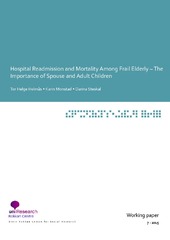| dc.description.abstract | In many Western societies, the aging of the population puts a strain on health care service delivery and financing. In particular, demand for specialist services attracts attention, as these services are the most costly. Developing adequate treatment at lower levels of care is a challenge, as well as stimulating prevention at different stages of illness; from prevention of incidence to preventing recurring need of hospitalization for those already suffering from an illness. Therefore, in several countries with different health care systems, for instance the USA, UK, Australia, Denmark, Sweden, and Norway, initiatives are taken to improve coordination of services and introduce specific readmission policy (Burgess and Hockenberry, 2014; see references in Grimsmo et al., 2015). As of January 1 2012, Norway introduced a large health service reform (hereafter «Care Coordination Reform»). The aim of this reform is to promote better integration of care services and primary and specialist health care services, as well as prevention of illness and strengthening of public health efforts. While the reform is clearly motivated by nonpecuniary aspects such as patient involvement and quality of services (less fragmented clinical pathways), one driving force is future health care costs. Two important strategies are to treat more patients in primary health care instead of at hospitals and to have hospitalized patients discharged earlier (Romøren et al., 2011). The Care Coordination Reform does not include elements specifically directed towards informal care provision. In this analysis, we study how individual patients’ outcomes – mortality and readmission – are related to the availability and characteristics of spouse2 and off‐spring (hereafter «family resources»). The analysis focuses on cases where good coordination is of particular importance, namely when a patient is discharged from hospital. Furthermore, it focuses on fragile patients; elderly who have been discharged with specific primary diagnoses (heart attack, heart failure, pneumonia, hip fracture), which are often used in the literature (see for instance Laudicella et al., 2013). Patient health (all‐cause mortality) and probability of readmission is investigated within a time frame of 30 days after hospital discharge. Readmission clearly incurs large costs both to the patient and the society. However, from the perspective of the individual patient’s welfare, it is not obvious how readmission should be viewed. It can be an indication of poor hospital treatment, for example, too early discharge, or of poor post‐hospitalization treatment, whether care is formal or informal. On the other hand, for fragile patients, there is inherently a high risk of complications, and readmissions may also be viewed as an indication that the health care system is responsive to changes in the medical needs of the individual patient. 3 In brief, the analysis addresses the following research questions: i) Do family resources affect mortality and readmission? ii) Are potential effects of family resources related to the characteristics of spouse and children? iii) Does the potential effect of relatives vary by patient diagnosis? iv) Does the potential effect vary by municipality characteristics? v) Has the association between family resources and patient outcomes changed over time, in particular, from the period before to the period after the Care Coordination Reform? Our analysis benefits from detailed individual‐level registry data over a 5 year period (2009‐ 2013). In light of the selection bias problem in this type of analysis (see sections 2 and 5), it is particularly important to have an extensive set of control variables. We have data on the availability of both spouse and off‐spring, as well as their demographic and socioeconomic characteristics. Regarding the patient, we also benefit from medical information that indicates health status, both prior to hospitalization and at the time of discharge. The paper proceeds as follows. Section 2 gives a brief overview of some related literature, followed by a description of the institutional framework in section 3. Our data is presented in section 4, while the empirical specification is outlined in section 5. Results are reported in section 6 and further discussed in section 7, which concludes the paper. | en_US |
